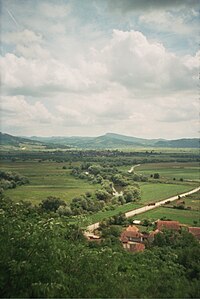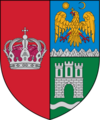Comăna: Difference between revisions
more fixes and links |
|||
| (11 intermediate revisions by 4 users not shown) | |||
| Line 1: | Line 1: | ||
{{Infobox Romanian subdivision |
{{Infobox Romanian subdivision |
||
|type |
|type = commune |
||
|county |
|county = Brașov |
||
| |
|image_shield = ROU BV Comana CoA.jpg |
||
|image_skyline = Comana.jpg |
|||
|official_name=Comăna |
|||
| ⚫ | |||
|image_shield=ROU BV Comana CoA.jpg |
|||
|image_map=Comana jud Brasov.jpg |
|image_map = Comana jud Brasov.jpg |
||
|image_location = |
|||
|leader_name=Viorel Grusea |
|||
|leader_name = Viorel Grusea<ref>{{cite web |url=https://prezenta.roaep.ro/locale27092020/romania-pv-final |title=Results of the 2020 local elections |publisher=Central Electoral Bureau |access-date=9 June 2021 |df=dmy-all}}</ref> |
|||
|leader_party= PNL |
|leader_party = PNL |
||
|area_total_km2=97.26 |
|||
|term = 2020–2024 |
|||
|coordinates={{coord|45|54|36|N|25|13|48|E|type:city_region:RO_source:frwiki|display=it}} |
|coordinates = {{coord|45|54|36|N|25|13|48|E|type:city_region:RO_source:frwiki|display=it}} |
||
|elevation = 430 |
|||
|elevation_min = |
|||
|elevation_max = |
|||
|area_total = 97.26 |
|||
|population_total = auto |
|||
|population_as_of = |
|||
|population_footnotes = |
|||
|postal_code = 507050 |
|||
|area_code = +40 x68 |
|||
|website = {{URL|https://www.comuna-comana.ro/}} |
|||
}} |
}} |
||
''' |
'''Comăna''' ({{langx|de|Kumanen, Komondjen}}; {{langx|hu|Alsókomána}}) is a [[Commune in Romania|commune]] in [[Brașov County]], [[Transylvania]], [[Romania]]. It is composed of four villages: Comăna de Jos (the commune center), Comăna de Sus (''Felsőkomána''), Crihalma (''Königsberg''; ''Királyhalma'') and Ticușu Nou (''Rumänisch Tekes''; ''Felsőtyúkos''). |
||
Comăna is traversed north to south by the [[Olt (river)|Olt River]]. It borders the following communes: [[Părău]] to the south, [[Măieruș]] to the east, [[Hoghiz]] to the north, and [[Ticușu]] to the west. |
|||
==History== |
==History== |
||
Comăna de Jos was an important administrative center of the eastern part of |
Comăna de Jos was an important administrative center of the eastern part of [[Țara Făgărașului]], at a time when {{ill|Ștefan Mailat|ro}} – who was born here in 1502 – ruled over [[Transylvania]]. Villages falling within the jurisdiction of this center were: Comăna de Sus, Veneția de Jos, Veneția de Jos, Crihalma, Ticușu Nou, Cuciulata, and Lupșa. In the current area of Comăna de Jos, human settlements were discovered that attest to the existence of people in the following places: |
||
* |
*A [[Bronze Age]] settlement from the 2nd to the 1st century B.C. |
||
*The [[La Tène culture]] is represented by a Hallstatt settlement from the 8th and 9th centuries. |
*The [[La Tène culture]] is represented by a [[Hallstatt culture|Hallstatt]] settlement from the 8th and 9th centuries. |
||
* |
*Settlements from the early medieval era (11th to 13th century). |
||
'''Important archaeological discoveries.''' |
'''Important archaeological discoveries.''' |
||
In Comăna de Jos, it was investigated that dwellings dug into the soil at different depths, being unveiled 14 huts and 18 little huts, with diverse planimetry with installation of fire ovens consisting of stone and clay. Was also found and existing facilities upgraded fire outdoors. Archaeological research from |
In Comăna de Jos, it was investigated that dwellings dug into the soil at different depths, being unveiled 14 huts and 18 little huts, with diverse planimetry with installation of fire ovens consisting of stone and clay. Was also found and existing facilities upgraded fire outdoors. Archaeological research from 1974 to 1976 concluded that construction traces, ruins and ceramics (by wheel and by hand) belong to various periods of time. Ceramic found here is similar to the one found in the areas inhabited by the [[Dacians]]. |
||
'''Early census''' |
'''Early census''' |
||
| Line 27: | Line 40: | ||
==Population== |
==Population== |
||
At the [[2011 Romanian census|2011 census]], the population of Comăna commune numbered 2,556 inhabitants. At [[2021 Romanian census|2021 census]], the population had increased to 2,803. |
|||
| ⚫ | |||
In 2011, the population of Comăna commune numbered 2,556 inhabitants. |
|||
| ⚫ | |||
{| class="toccolours" style="margin: 0 1em 0 1em;" width="60%" |
{| class="toccolours" style="margin: 0 1em 0 1em;" width="60%" |
||
|- |
|- |
||
| Line 164: | Line 176: | ||
| 0 |
| 0 |
||
| 95 |
| 95 |
||
|- |
|||
| Height="12,75" | 2021 |
|||
| 2,803 |
|||
| |
|||
| |
|||
| |
|||
| |
|||
| |
|||
| |
|||
|} |
|} |
||
==Natives== |
==Natives== |
||
*Ștefan Mailat (1502–1550) – captain of [[Făgăraș Citadel]] and [[Prince of Transylvania]]. |
*Ștefan Mailat (1502–1550) – captain of [[Făgăraș Citadel]] and [[Prince of Transylvania]]. |
||
| Line 173: | Line 193: | ||
<gallery> |
<gallery> |
||
Image:Josephinische Landaufnahme pg242.jpg|Old map of Comăna de Jos and the area |
Image:Josephinische Landaufnahme pg242.jpg|Old map of Comăna de Jos and the area |
||
File:Primăria Comăna, județul Brașov.JPG|Town Hall |
|||
| ⚫ | |||
Image:ComanadeJos.JPG|Church in Comăna de Jos |
Image:ComanadeJos.JPG|Church in Comăna de Jos |
||
</gallery> |
</gallery> |
||
| ⚫ | |||
| ⚫ | |||
==External links== |
==External links== |
||
*[https://web.archive.org/web/20100921221410/http://www.comuna-comana.ro/ The official site of Comăna commune] |
*[https://web.archive.org/web/20100921221410/http://www.comuna-comana.ro/ The official site of Comăna commune] |
||
*[http://www.comanadejos.blogspot.com/ An unofficial site of Comăna de Jos] |
*[http://www.comanadejos.blogspot.com/ An unofficial site of Comăna de Jos] |
||
| ⚫ | |||
| ⚫ | |||
{{Braşov County}} |
{{Braşov County}} |
||
{{Authority control}} |
|||
{{DEFAULTSORT:Comana}} |
{{DEFAULTSORT:Comana}} |
||
Latest revision as of 08:34, 27 October 2024
Comăna | |
|---|---|
 View over Comăna commune | |
 Location within the county | |
| Coordinates: 45°54′36″N 25°13′48″E / 45.91000°N 25.23000°E | |
| Country | Romania |
| County | Brașov |
| Government | |
| • Mayor (2020–2024) | Viorel Grusea[1] (PNL) |
Area | 97.26 km2 (37.55 sq mi) |
| Elevation | 430 m (1,410 ft) |
| Population (2021-12-01)[2] | 2,803 |
| • Density | 29/km2 (75/sq mi) |
| Time zone | EET/EEST (UTC+2/+3) |
| Postal code | 507050 |
| Area code | +40 x68 |
| Vehicle reg. | BV |
| Website | www |
Comăna (German: Kumanen, Komondjen; Hungarian: Alsókomána) is a commune in Brașov County, Transylvania, Romania. It is composed of four villages: Comăna de Jos (the commune center), Comăna de Sus (Felsőkomána), Crihalma (Königsberg; Királyhalma) and Ticușu Nou (Rumänisch Tekes; Felsőtyúkos).
Comăna is traversed north to south by the Olt River. It borders the following communes: Părău to the south, Măieruș to the east, Hoghiz to the north, and Ticușu to the west.
History
[edit]Comăna de Jos was an important administrative center of the eastern part of Țara Făgărașului, at a time when Ștefan Mailat – who was born here in 1502 – ruled over Transylvania. Villages falling within the jurisdiction of this center were: Comăna de Sus, Veneția de Jos, Veneția de Jos, Crihalma, Ticușu Nou, Cuciulata, and Lupșa. In the current area of Comăna de Jos, human settlements were discovered that attest to the existence of people in the following places:
- A Bronze Age settlement from the 2nd to the 1st century B.C.
- The La Tène culture is represented by a Hallstatt settlement from the 8th and 9th centuries.
- Settlements from the early medieval era (11th to 13th century).
Important archaeological discoveries. In Comăna de Jos, it was investigated that dwellings dug into the soil at different depths, being unveiled 14 huts and 18 little huts, with diverse planimetry with installation of fire ovens consisting of stone and clay. Was also found and existing facilities upgraded fire outdoors. Archaeological research from 1974 to 1976 concluded that construction traces, ruins and ceramics (by wheel and by hand) belong to various periods of time. Ceramic found here is similar to the one found in the areas inhabited by the Dacians.
Early census In 1733, when the Romanian Greek Catholic bishop Inocențiu Micu-Klein decided to organize a census in Transylvania, 34 families were reviewed in the village of Comăna de Jos. In other words, in Comăna de Jos of the year 1733, there were around 170 inhabitants. In the same census is to be noted that in Comăna de Jos there were two Greek Catholic priests, both having the surname Iuon (John). The village had a Greek Catholic church and a manse. The name of the village was written in Hungarian as Alsó-Komana, whereas the results were intended for a committee consisting of non-Romanians, mostly Hungarians.
Population
[edit]At the 2011 census, the population of Comăna commune numbered 2,556 inhabitants. At 2021 census, the population had increased to 2,803.
The population between 1850 and 2021, according to the Hungarian and Romanian censuses:
| Census of Comăna | Ethnic structure | |||||||
|---|---|---|---|---|---|---|---|---|
| Year | Population | Romanians | Hungarians | Germans | Roma | Ukrainians | Other | |
| 1850 | 3,437 | 3,311 | 9 | - | 117 | |||
| 1857 | 3,578 | |||||||
| 1880 | 3,419 | 3,140 | 124 | 10 | 147 | |||
| 1890 | 3,383 | 3,164 | 158 | 9 | 52 | |||
| 1900 | 3,435 | 3,223 | 145 | 34 | 33 | 1 | ||
| 1910 | 3,580 | 3315 | 177 | 25 | 63 | 5 | 1 | |
| 1920 | 3,620 | 3,569 | 37 | 14 | ||||
| 1930 | 3,519 | 3,442 | 38 | 7 | 32 | |||
| 1941 | 3,312 | 3,069 | 18 | - | 225 | |||
| 1956 | 3,254 | 2,956 | 20 | 2 | 276 | |||
| 1966 | 3,135 | 2,867 | 23 | - | 245 | |||
| 1977 | 2,822 | 2,351 | 9 | 3 | 459 | |||
| 1992 | 2,619 | 1,575 | 11 | 1 | 1,032 | |||
| 2002 | 2,635 | 2,005 | 11 | 0 | 616 | 1 | 2 | |
| 2011 | 2,556 | 2,083 | 3 | 0 | 375 | 0 | 95 | |
| 2021 | 2,803 | |||||||
Natives
[edit]- Ștefan Mailat (1502–1550) – captain of Făgăraș Citadel and Prince of Transylvania.
Gallery
[edit]-
Old map of Comăna de Jos and the area
-
Town Hall
-
Church in Comăna de Jos
References
[edit]- ^ "Results of the 2020 local elections". Central Electoral Bureau. Retrieved 9 June 2021.
- ^ "Populaţia rezidentă după grupa de vârstă, pe județe și municipii, orașe, comune, la 1 decembrie 2021" (XLS). National Institute of Statistics.






